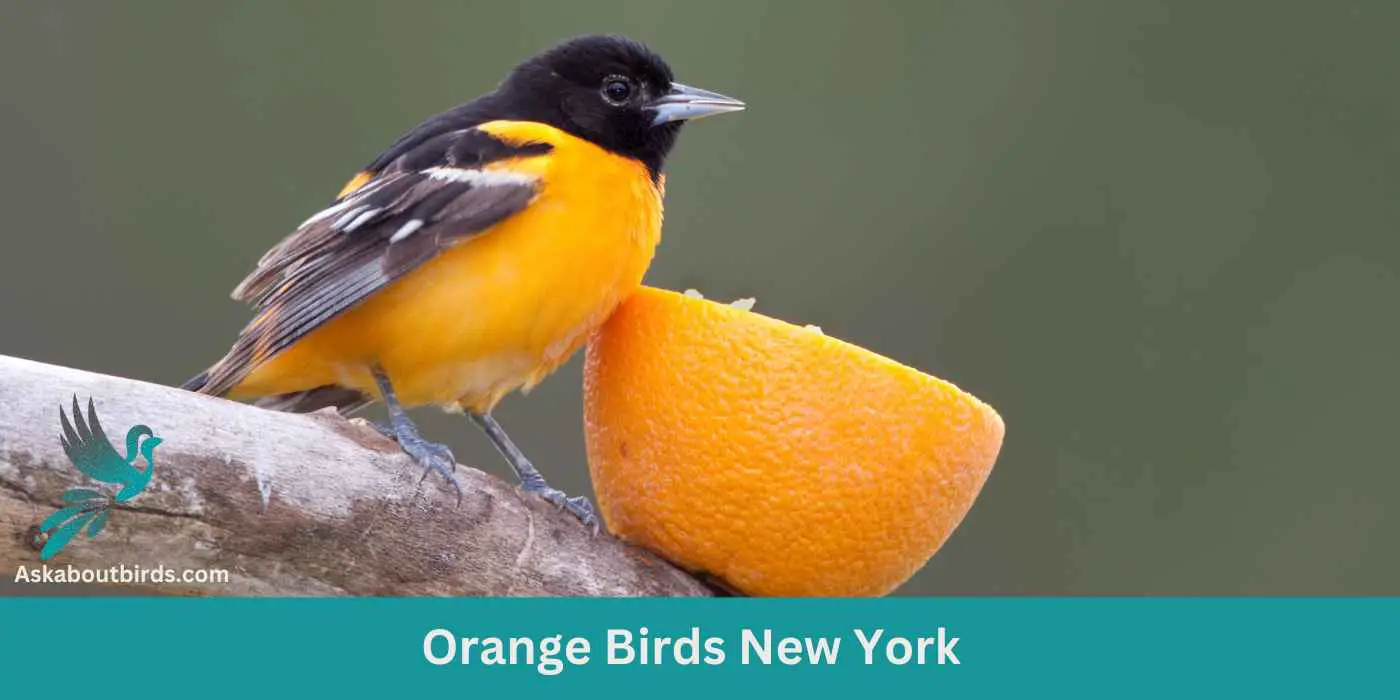From the bustling heart of Manhattan to the serene landscapes of the Adirondacks, New York state is a haven for diverse birdlife. Among its feathery inhabitants, a special group of birds stands out with their striking orange hues, painting the skies and trees with vibrant splashes of color.
In this guide, we’ll journey through the Empire State, introducing you to 10 mesmerizing orange birds that call New York their home. Whether you’re an avid birdwatcher or just an admirer of nature’s beauty, these feathered marvels are sure to captivate your heart.
Orange Birds Found In New York
New York boasts a diverse landscape from the bustling streets of NYC to the serene Adirondack Mountains and the expansive Great Lakes.
The state of New York presents a rich tapestry of habitats, from coastal estuaries and urban parks to dense forests and sprawling freshwater lakes. This topographical diversity, combined with its location along significant migratory routes, ensures a varied bird population.The state’s varied ecosystems, provide niches for both resident birds and transient visitors, making it a birdwatcher’s paradise throughout the year.
American Robins


| Feature | Measurement |
|---|---|
| Scientific Name | Leptotila plumbeicep |
| Length | 10.6-11.8 in |
| Wingspan | — |
| Weight | 160-200 g |
The American Robin is a widely recognized bird species known for its melodious song and early bird tendencies.
Appearance: American Robins are medium-sized birds with a distinctive appearance. Both males and females sport a gray to brown back and a warm red to orange breast and belly and gray wings. They also have a characteristic white eye-ring and a black head, but males are usually darker than females.
Diet: American Robins have a diverse diet that changes depending on the season. In summer, they feed heavily on earthworms, beetles, and other invertebrates, which they catch on the ground. During winter, they mostly eat fruits and berries.
Reproduction: American Robins usually build their nests in trees or shrubs, but they are also known to nest on human-made structures. The female lays a clutch of about 3 to 5 eggs, which she incubates for about 12 to 14 days.
Barn Swallow

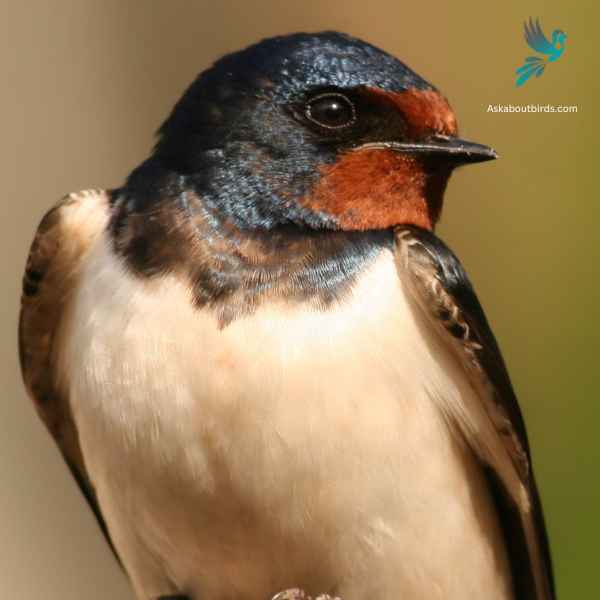
| Feature | Measurement |
|---|---|
| Scientific Name | Hirundo rustica |
| Length | 6.5–7.5 in |
| Wingspan | 12.5–13.5 in |
| Weight | 16–22 g |
The Barn Swallow is a sleek, agile bird renowned for its graceful flight patterns and iconic forked tail, often seen darting over fields and water bodies in search of flying insects.
Appearance: Barn Swallows have deep blue, almost iridescent, upperparts and a rufous to tawny underbelly. Their distinctively forked tail and long wings give them a streamlined look. Both males and females have a similar appearance, though males often exhibit slightly brighter colors and a deeper fork in the tail.
Diet: Barn Swallows feed primarily on flying insects, which they catch in mid-air during their agile and acrobatic flights. Their diet includes flies, beetles, moths, and other small flying insects.
Reproduction: Barn Swallows are known for building their mud nests on man-made structures, particularly barns, bridges, and eaves. The nest is cup-shaped and made from mud pellets, often lined with feathers. The female lays a clutch of 4 to 6 eggs.
Barn Swallow


| Feature | Measurement |
|---|---|
| Scientific Name | Hirundo rustica |
| Length | 6.5–7.5 in |
| Wingspan | 12.5–13.5 in |
| Weight | 16–22 g |
The Barn Swallow is a sleek, agile bird renowned for its graceful flight patterns and iconic forked tail, often seen darting over fields and water bodies in search of flying insects.
Appearance: Barn Swallows have deep blue, almost iridescent, upperparts and a rufous to tawny underbelly. Their distinctively forked tail and long wings give them a streamlined look. Both males and females have a similar appearance, though males often exhibit slightly brighter colors and a deeper fork in the tail.
Diet: Barn Swallows feed primarily on flying insects, which they catch in mid-air during their agile and acrobatic flights. Their diet includes flies, beetles, moths, and other small flying insects.
Reproduction: Barn Swallows are known for building their mud nests on man-made structures, particularly barns, bridges, and eaves. The nest is cup-shaped and made from mud pellets, often lined with feathers. The female lays a clutch of 4 to 6 eggs.
Baltimore Oriole


| Feature | Measurement |
|---|---|
| Scientific Name | Icterus galbula |
| Length | 6.7–8.7 in |
| Wingspan | 9.1–12.6 in |
| Weight | 22.3-42 g |
The Baltimore Oriole is a stunning bird, best known for its vibrant coloration and its rich, whistling song.
Appearance: The male Baltimore Oriole is notable for his bright orange and black plumage and black and white wing bars, a stark contrast to the more muted yellow-brown coloration of the female. Both sexes, however, have long pointed bills and white bars on their wings.
Diet: Baltimore Orioles have a diverse diet that includes insects, fruits, and nectar. Their preference for sweet juices and fruit pulp often brings them to backyard feeders offering oranges and jelly.
Reproduction: The female Baltimore Oriole is responsible for building the distinctive hanging nest, often woven together from fine materials like hair and grass. These nests are usually high in trees to avoid predators. The female lays 3-7 eggs, which are incubated for about two weeks.
American Redstart


| Feature | Measurement |
|---|---|
| Scientific Name | Setophaga ruticilla |
| Length | 4.3 to 5.5 in |
| Wingspan | 6.3 to 9.1 in |
| Weight | 8.6 g |
The American Redstart is a lively warbler known for its vivid colors and active hunting style, often seen flitting about, fanning its tail to startle and catch insects.
Appearance: Adult male American Redstarts boast striking black plumage with bright orange patches on the sides, wings, and tail. Females and immature males have grayish-olive upperparts with yellow patches in the same areas where the males display orange.
Diet: American Redstarts are primarily insectivores. They actively forage for flying insects, as well as caterpillars and spiders, often using their colorful tails to startle prey and make them easier to catch.
Reproduction: The female American Redstart builds a cup-shaped nest in the fork of a tree branch. Typically, she lays a clutch of 3 to 5 eggs. The female takes on the primary responsibility of incubating the eggs, while both parents participate in feeding the fledglings after they hatch.
Scarlet Tanager


| Feature | Measurement |
|---|---|
| Scientific Name | Piranga olivacea |
| Length | 6.3 to 7.5 in |
| Wingspan | 9.8 to 11.8 in |
| Weight | 23.5 to 38 g |
The Scarlet Tanager is a strikingly colorful bird known for its brilliant plumage and distinctive song.
Appearance: Male Scarlet Tanagers are notable for their vibrant scarlet bodies contrasted with black wings and tail, making them one of the most intensely colored birds. Females and juveniles, on the other hand, have a subdued olive-yellow body color with darker wings and tail.
Diet: The diet of the Scarlet Tanager is largely made up of insects, including beetles, cicadas, aphids, and others. They are adept flycatchers, seizing insects in mid-air or picking them off foliage. They also consume fruits and berries, especially during migration and in their winter habitats.
Reproduction: The female Scarlet Tanager builds a cup-shaped nest using twigs, rootlets, and grass, typically well-hidden in the dense foliage of trees. She lays 3 to 5 eggs and incubates them for about two weeks.
Eastern Towhee

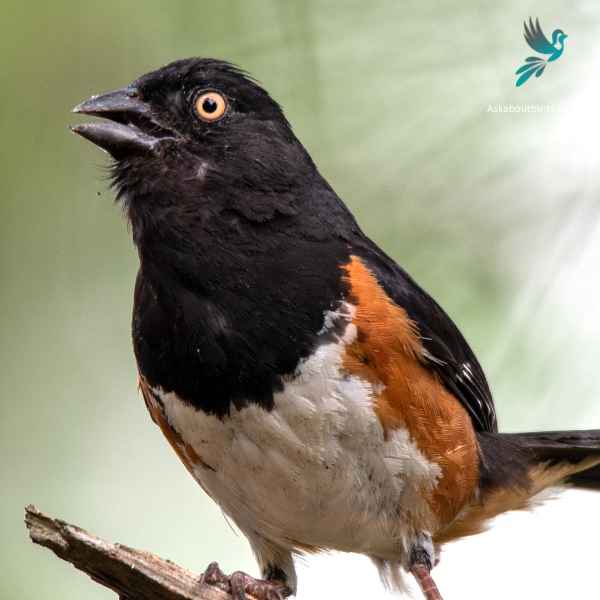
| Feature | Measurement |
|---|---|
| Scientific Name | Pipilo erythrophthalmus |
| Length | 6.8 to 9.1 in |
| Wingspan | 7.9–11.8 in |
| Weight | 32 to 53 g |
The Eastern Towhee is a distinctive songbird known for its unique calls and eye-catching coloration.
Appearance: Male Eastern Towhees are characterized by a striking combination of a black head, back and tail, contrasting with a white belly and rufous flanks. Females sport similar patterns but instead of black, they have a rich brown color. Both genders have red eyes, lending a special charm to their overall appearance.
Diet: Eastern Towhees primarily feed on a variety of insects, seeds, and berries. Their diet is quite diverse, taking advantage of seasonal offerings, which includes beetles, caterpillars, spiders, acorns, grass seeds, and various fruits and berries.
Reproduction: Eastern Towhees build their nests on or near the ground, often in a shrub or a small tree. The female lays around 3-5 eggs and takes the primary role in incubating them over about 12-13 days.
Northern Flicker

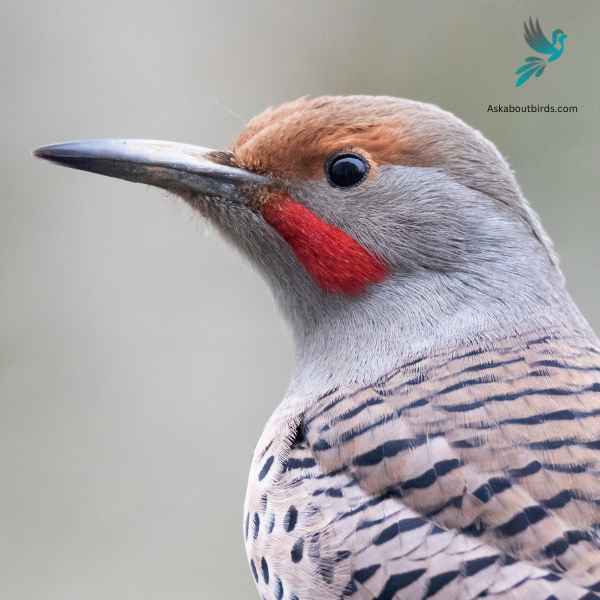
| Feature | Measurement |
|---|---|
| Scientific Name | Colaptes auratus |
| Length | 11–12 in |
| Wingspan | 17–20 in |
| Weight | 3.9–5.6 oz |
The Northern Flicker is a medium-sized woodpecker, recognized by its unique patterns and coloring, often found drumming on trees or foraging on the ground across North America.
Appearance: The Northern Flicker stands out with its grayish brown body, black-scalloped plumage, and a black bib. Males sport a distinctive black or red mustache stripe. Depending on the subspecies, the underwing and undertail feathers can be bright yellow or red, flashing vividly during flight.
Diet: While most woodpeckers are tree-bark foragers, the Northern Flicker prefers hunting on the ground. Its primary diet consists of ants and beetles, supplemented occasionally by fruits, berries, seeds, and other small insects.
Reproduction: Northern Flickers are cavity nesters, preferring to excavate their nesting hole in dead or diseased tree trunks. The interior of the nest is lined with wood chips.
Blackburnian Warbler
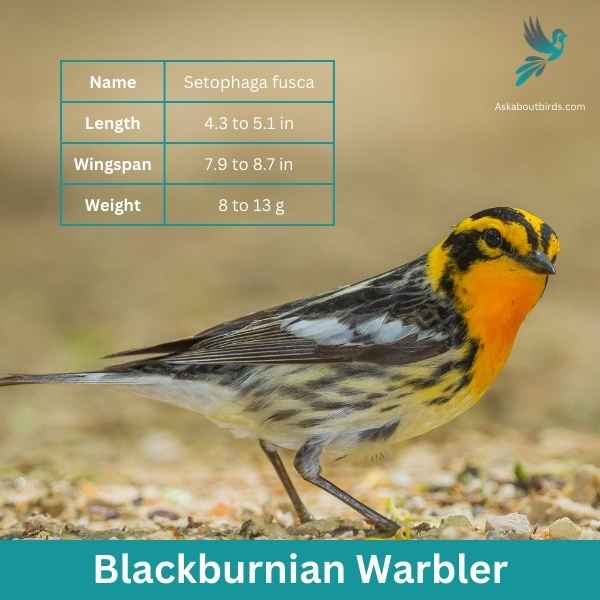

| Feature | Measurement |
|---|---|
| Scientific Name | Setophaga fusca |
| Length | 4.3 to 5.1 in |
| Wingspan | 7.9 to 8.7 in |
| Weight | 8 to 13 g |
The Blackburnian Warbler is a strikingly colored songbird that captivates observers with its vivid plumage, especially during the breeding season. Often found flitting high in the treetops of North American forests, its melodious song is as enchanting as its appearance.
Appearance: Male Blackburnian Warblers are distinguished by their fiery-orange throats, contrasting sharply with a black face, crown, and streaked back. They also have white underparts with black streaks on the sides. Females have a more muted coloration, with a yellowish or pale orange throat and less pronounced streaking.
Diet: Blackburnian Warblers primarily feed on insects and spiders. They are adept at foraging in the canopy, where they glean insects from the surface of leaves and branches or catch them mid-air in quick, agile flights.
Reproduction: Blackburnian Warblers build their nests high up in coniferous trees, often on horizontal branches. The nest is a neat cup made of twigs, grass, and moss, lined with softer materials like hair or feathers. The female lays a clutch of 4 to 5 eggs and takes the lead in incubation.
Red-breasted Nuthatch

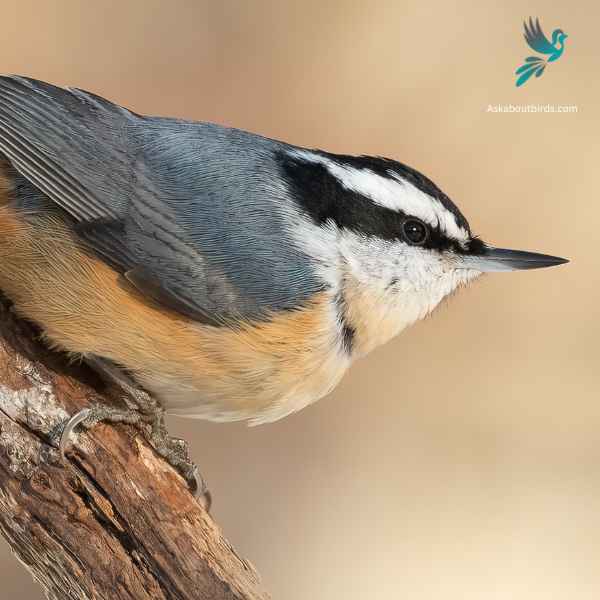
| Feature | Measurement |
|---|---|
| Scientific Name | Sitta canadensis |
| Length | 4.3–4.7 in |
| Wingspan | 8.3 in |
| Weight | 0.3–0.5 oz |
The Red-breasted Nuthatch is a small, agile songbird, known for its ability to move headfirst down tree trunks while searching for food.
Appearance: This bird boasts a slate-blue back and a pale rust-red underside. A prominent black stripe runs through the eye and is bordered above by a white eyebrow. Their sharp, pointed bill is characteristic of the species.
Diet: Red-breasted Nuthatches primarily feed on insects and seeds, especially those from coniferous trees. They have a fondness for large seeds, which they wedge into bark crevices to hack open with their bills.
Reproduction: These birds construct nests in natural tree cavities or abandoned woodpecker holes, often lining the entrance with resin. This is thought to deter predators or competitors from entering. The female typically lays a clutch of 5 to 6 eggs, and both parents partake in feeding the chicks once they hatch.
Orchard Oriole
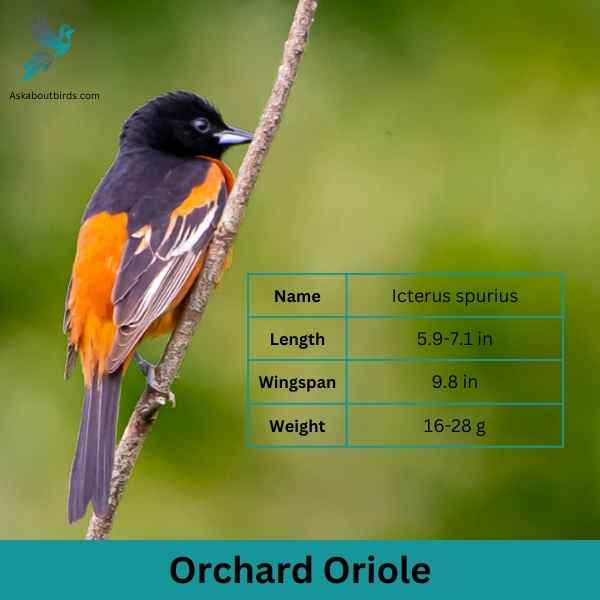
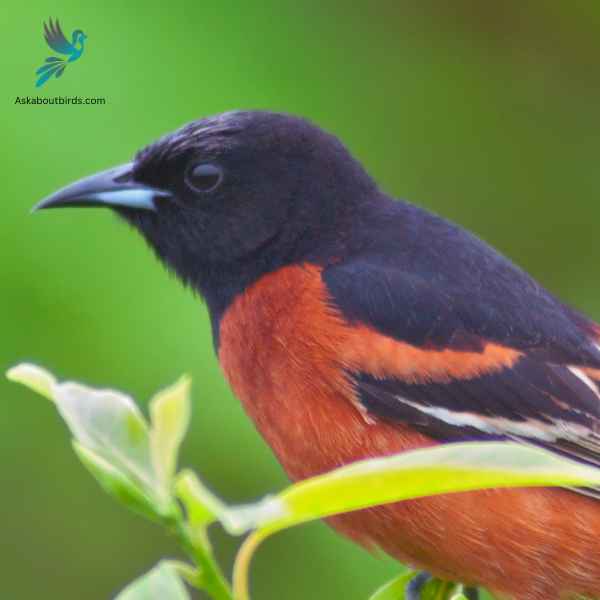
| Feature | Measurement |
|---|---|
| Scientific Name | Icterus spurius |
| Length | 5.9-7.1 in |
| Wingspan | 9.8 in |
| Weight | 16-28 g |
The Orchard Oriole is a small songbird noted for its distinctive coloration and melodic song.
Appearance: Male Orchard Orioles are a striking sight with their dark chestnut body and black head and black and white wings, while females and immature males are olive-green and feature a yellowish underpart. The species is often recognized by its slender body and pointed bill.
Diet: The diet of the Orchard Oriole consists primarily of insects, fruits, and nectar. They are adept at catching insects mid-air and are also known to sip nectar from flowers, aiding in pollination. When fruits are in season, they make up a substantial portion of the bird’s diet.
Reproduction: Orchard Orioles often nest in open woodlands and orchards, hence their name. The female is responsible for building the nest, typically choosing a location in a tree or shrub. The female lays a clutch of 4 to 6 eggs, which she incubates for about two weeks.
Where to Spot New York’s Orange Birds
New York, with its vast and varied terrains, offers a plethora of bird-watching opportunities, especially for enthusiasts in search of vibrant orange birds. From the mountainous regions to its serene coastlines, here are some of the top spots in the Empire State to observe its feathery residents:
- Central Park, New York City: An oasis in the midst of the bustling city, Central Park is a hotspot for migratory birds. With over 230 species recorded, its Ramble area is particularly renowned for bird watching, especially in spring and fall.
- Montezuma National Wildlife Refuge: Situated at the northern end of Cayuga Lake in the Finger Lakes region, this refuge attracts over a quarter million waterfowl during spring and fall migrations. Its vast wetlands and marshes make it a perfect habitat for diverse bird species.
- Mashomack Preserve on Shelter Island: Covering a third of Shelter Island, this preserve offers tidal creeks, mature oak woodlands, and freshwater marshes. It’s an exceptional spot to see both resident and migratory birds in a relatively undisturbed setting.
- Sterling Forest State Park: Located in the southeastern part of the state, the park’s extensive forested regions provide habitat for many bird species, including the elusive cerulean warbler and other songbirds.
- Jones Beach State Park: A key location on the Atlantic Flyway, this coastal park is ideal for spotting shorebirds, especially during migration periods. Its diverse habitats range from maritime forests to salt marshes, attracting a myriad of bird species.
| State’s Orange Birds | Top Spots for Orange Birds |
|---|---|
| New Jersey’s Orange Birds | Cape May Point State Park, Great Swamp National Wildlife Refuge, The Meadowlands |
| Pennsylvania’s Orange Birds | Hawk Mountain Sanctuary, Presque Isle State Park, Middle Creek Wildlife Management Area |
| Vermont’s Orange Birds | Dead Creek Wildlife Management Area, Green Mountain Audubon Center, Missisquoi National Wildlife Refuge |
| Massachusetts’ Orange Birds | Plum Island – Parker River National Wildlife Refuge, Quabbin Reservoir, Cape Cod National Seashore |
| Connecticut’s Orange Birds | Hammonasset Beach State Park, Lighthouse Point Park, White Memorial Conservation Center |
FAQs on Orange Bird Species Found in New York
What bird is bright orange in New York State?
In New York State, the Baltimore Oriole is a bird known for its bright orange and black coloration. Particularly in males, this rusty orange breast is contrasted with black on the head, back, and wings, making them quite conspicuous.
What kind of bird has an orange chest in upstate NY?
In upstate New York, the Scarlet Tanager is notable for its bright orange plumage. Males especially are vivid, with a bright red body contrasted by black wings and tail. These birds are often found in deciduous and mixed forests during the breeding season.
What bird is brown and orange in NY?
The Eastern Towhee is a bird found in New York that showcases a combination of brown and orange. The males have a black head, back, and tail with an orange-red side and white belly, while females replace the black with a warm brown. They can be seen scratching at the leaf litter in wooded and shrubby areas in search of food. Or the Cedar Waxwing which has orange brown with dark gray wings.
How to Attract Birds to Bird Feeders or a Bird Feeding Station in NY?
To attract a diverse range of birds, including vibrant yellow birds, to your bird feeder in NY, consider using black oil sunflower seeds. These seeds are a favorite among many bird species and will ensure frequent visits to bird feeders. The high-fat content in black oil sunflower seeds is especially appealing. Additionally, offering grape jelly can get other birds to visit bird feeders that enjoy its sweet flavor. By providing a variety of food sources, your feeding station will soon become a hotspot for various birds in the region.

